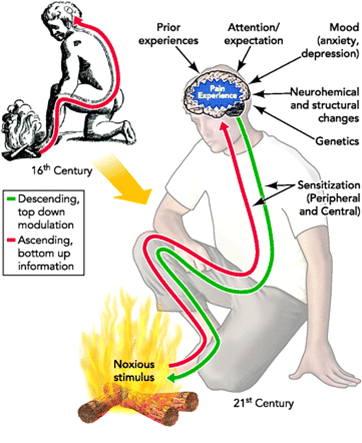Pain Science Education in Physical Therapy practice
What is pain?
Pain is our brain’s interpretation that a stimulus is a threat to our physical condition.

For example, on a hike you feel a dull poke on your leg. Looking down, you note a low branch and continue your hike. While taking shower, you feel a sting or burn with the water. You notice a cut. Why didn’t you feel pain when the branch poked you?
The poke of the branch on your skin is a mechanical stimulus. The stimulus sends a signal from your skin to your brain via nerves. Past experiences, attention, expectation, current mood, and the severity of tissue damage affect the interpretation of a threat. Moreover, the brain interprets the poke as being a low threat. There has been tissue damage since the branch caused an abrasion. Now, water, typically not a threat, has become an noxious (unpleasant) stimulus. Therefore, your brain assesses the branch just as it assesses the water. It takes into consideration your attention, expectations, current mood, and tissue damage. Subsequently, it interprets water as being a high threat as the skin has been broken and free nerve endings are exposed. Withdrawing your leg from the shower, you see a small, shallow cut. You lower your leg back down. Repetition of water on the cut reduces the novelty of pain. Furthermore, the brain now does not interpret water as a high threat.
Is pain in the brain?
Tissue damage causes a perception of pain. However, the intensity of a painful stimulus is not linear to the subjective painful experience. The response to a stimulus is subjective and individual. Subsequently, expectations affect the response.
Knowledge is treatment
Understanding how perception, mood, and past experiences influence pain will help you navigate your pain response. In physical therapy practice, movement is often interpreted as a threat. If I turn my head to the right, my neck hurts. Pain science education can be applied with physical therapy to lower the expectation of threat with habituation of therapeutic movement or introduction of correct movement patterns.
Movement is medicine and we have a wide variety of movement exercises that help to reduce pain on our Youtube Channel. Let us know which exercises you try and comment below with your favorites! Furthermore, if you want to speak to one of our Physical Therapists about your specific pain and what we can do to help, contact us & we would be happy to set up a call.
